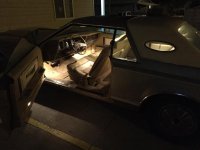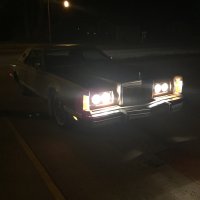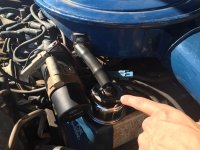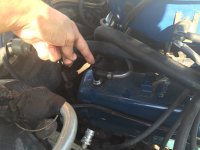Redliner
Over 1,000 Posts
I know there are some mechanics of the Ford persuasion on this board and I'm calling out for help with something I just can't track down.
It's a 1977 Lincoln with Ford 460 motor and C6 trans. Motorcraft 4bbl carb and everything is stock except that the timing is restored to the correct pre-1972 position.
I picked this up about four-months ago and as I've driven it's gotten worse and worse to the point it's now undriveable.
In July, I'm in Wyoming and I find this. The mornings there were about 57° and the days up to 90°.
I bought it after it had sat for three-years. Drove it home, rebuilt the carb with new parts, replaced the cap & rotor, plugs and wires, all fluids, set ignition timing and it ran right.
I took it out for a few nights. On the highway it would just cruise like a dream. It had all the power in the world. Doing 40-60 drop-gear accelerating would raise the hood at least 6" up and the tires would sometimes come unhooked.
It started so easily in the mornings that all I had to do was flick the key for a split second and it would jump to life and idle so well it was too good to be true.
One day I was driving just after noon and was braking at a stop light when suddenly, without warning, my oil light came on to warn me I lost pressure. Sure enough the brakes and steering were gone as well. It died. Out like a light.
I started it again and it took a little long to crank. I parked in a nearby car park and it happened again.
I waited five minutes and it started up fine, so I drove home and started wondering what the hell that was about.
Well now and then it would just die. The cranking times increased too.
I had to leave Wyoming at the beginning of August. I headed out towards Texas and about twenty minutes on the road I started getting some horrible racket from my exhaust. It sounded like a little machine gun blapping. I learned it would do it if I maintained a certain throttle position. If I tried to accelerate or decelerate, it would eventually stop.
In the higher altitude parts, I would adjust the timing to compensate and it would accelerate better, but that blapping in the pipes stayed with me until New Mexico and when it would happen I would practically lose power, the RPM's would drop almost to the point of dying and sounded very hollow.
I got to Texas and now it's bucking and dying constantly.
Sometimes it would lose RPM then would wa-wa (if you're familiar with records) and sputter out, other times it was off like a LIGHT. Even on the highway I have had it shut off.
I drove it from Dallas to Austin and back without any issue, but at both places in stop and go, it was just a hair-pulling experience. It got to the point it wouldn't even start in the morning at all. Sometimes it wanted a little choke, sometimes none at all. Sometimes it would start with the TSP off, sometimes it wanted it on. Most days I would have to wait TWENTY MINUTES before I could apply throttle without sputtering out! Yes, the choke IS opening automatically.
Now I just don't drive it. The last time I did, it died on a 30-minute highway ride three times. The last time, it simply would NOT start. It would only hit once or twice but never really start. Weird thing is that there was power steering fluid puddled in an area that was just a MESS. It's like it was coughing the stuff up, but my power steering fluid level is fine...
What is this witchcraft?! How could this have happened?
Now I'm staring at the thing wondering how cool it would be to watch it burn.
TL;DR
Here's the info I've concluded:
Number 4 cylinder is NOT running. Unplug #4 and it makes practically no difference.
All cylinders are exactly 150psi, air filter off and throttle wide open.
No lifter tick.
No vacuum leaks from anything attached to the ports on the EGR plate or carb. I have taken the hoses off of all vacuum ports directly at the source and plugged them.
I did spot a crack in the intake manifold gasket that was sucking in carb cleaner. I replaced the gasket and glad I did, both cylinder banks did have obvious carbon tracks where vacuum was leaking.
None of the pushrods were bent.
There is a squeaking sound coming from my exhaust. Sounds very similar to some vacuum leaks I've heard on motorcycles. It's a chirping pattern. If you hold a piece of paper over the exhaust, now and then it will suck it inward. Keep in mind I have a 2-2 exhaust with an H-pipe and Magnaflows.
Currently:
While running it will idle ok when cold even though #4 is dead.
It constantly shudders, at times it begins to buck.
Once hot, RPM will drop from 900 to 650 VERY suddenly, within an instant, then sometimes recover just as quickly or die altogether.
Watching spark on all other cylinders with a little inline spark light, I never lose spark to ANY cylinder.
No spark leaking to another ground source.
Watching the timing on each cylinder (my flywheel is marked with 8 TDC marks) all are perfectly alike to one another and does not fluctuate. It's a Duraspark II and is rock solid in its advance at idle.
Voltage is maintained at 14.3v and when the idle drops to 650 may go as low as 13.3.
Parts I've swapped with a known working 1978 Mark V with the same motor:
Plug wires
Distributor
Ignition control module
Coil
At this point I'm almost certain I have multiple issues. Sometimes it dips in RPM's then dies, other times it shudders horribly and RPM's wa-wa, and then on the highway it can just go out like a light or rev with a hollow sound but no power...
Thanks to anybody that's read this far at least!
It's a 1977 Lincoln with Ford 460 motor and C6 trans. Motorcraft 4bbl carb and everything is stock except that the timing is restored to the correct pre-1972 position.
I picked this up about four-months ago and as I've driven it's gotten worse and worse to the point it's now undriveable.
In July, I'm in Wyoming and I find this. The mornings there were about 57° and the days up to 90°.
I bought it after it had sat for three-years. Drove it home, rebuilt the carb with new parts, replaced the cap & rotor, plugs and wires, all fluids, set ignition timing and it ran right.
I took it out for a few nights. On the highway it would just cruise like a dream. It had all the power in the world. Doing 40-60 drop-gear accelerating would raise the hood at least 6" up and the tires would sometimes come unhooked.
It started so easily in the mornings that all I had to do was flick the key for a split second and it would jump to life and idle so well it was too good to be true.
One day I was driving just after noon and was braking at a stop light when suddenly, without warning, my oil light came on to warn me I lost pressure. Sure enough the brakes and steering were gone as well. It died. Out like a light.
I started it again and it took a little long to crank. I parked in a nearby car park and it happened again.
I waited five minutes and it started up fine, so I drove home and started wondering what the hell that was about.
Well now and then it would just die. The cranking times increased too.
I had to leave Wyoming at the beginning of August. I headed out towards Texas and about twenty minutes on the road I started getting some horrible racket from my exhaust. It sounded like a little machine gun blapping. I learned it would do it if I maintained a certain throttle position. If I tried to accelerate or decelerate, it would eventually stop.
In the higher altitude parts, I would adjust the timing to compensate and it would accelerate better, but that blapping in the pipes stayed with me until New Mexico and when it would happen I would practically lose power, the RPM's would drop almost to the point of dying and sounded very hollow.
I got to Texas and now it's bucking and dying constantly.
Sometimes it would lose RPM then would wa-wa (if you're familiar with records) and sputter out, other times it was off like a LIGHT. Even on the highway I have had it shut off.
I drove it from Dallas to Austin and back without any issue, but at both places in stop and go, it was just a hair-pulling experience. It got to the point it wouldn't even start in the morning at all. Sometimes it wanted a little choke, sometimes none at all. Sometimes it would start with the TSP off, sometimes it wanted it on. Most days I would have to wait TWENTY MINUTES before I could apply throttle without sputtering out! Yes, the choke IS opening automatically.
Now I just don't drive it. The last time I did, it died on a 30-minute highway ride three times. The last time, it simply would NOT start. It would only hit once or twice but never really start. Weird thing is that there was power steering fluid puddled in an area that was just a MESS. It's like it was coughing the stuff up, but my power steering fluid level is fine...
What is this witchcraft?! How could this have happened?
Now I'm staring at the thing wondering how cool it would be to watch it burn.
TL;DR
Here's the info I've concluded:
Number 4 cylinder is NOT running. Unplug #4 and it makes practically no difference.
All cylinders are exactly 150psi, air filter off and throttle wide open.
No lifter tick.
No vacuum leaks from anything attached to the ports on the EGR plate or carb. I have taken the hoses off of all vacuum ports directly at the source and plugged them.
I did spot a crack in the intake manifold gasket that was sucking in carb cleaner. I replaced the gasket and glad I did, both cylinder banks did have obvious carbon tracks where vacuum was leaking.
None of the pushrods were bent.
There is a squeaking sound coming from my exhaust. Sounds very similar to some vacuum leaks I've heard on motorcycles. It's a chirping pattern. If you hold a piece of paper over the exhaust, now and then it will suck it inward. Keep in mind I have a 2-2 exhaust with an H-pipe and Magnaflows.
Currently:
While running it will idle ok when cold even though #4 is dead.
It constantly shudders, at times it begins to buck.
Once hot, RPM will drop from 900 to 650 VERY suddenly, within an instant, then sometimes recover just as quickly or die altogether.
Watching spark on all other cylinders with a little inline spark light, I never lose spark to ANY cylinder.
No spark leaking to another ground source.
Watching the timing on each cylinder (my flywheel is marked with 8 TDC marks) all are perfectly alike to one another and does not fluctuate. It's a Duraspark II and is rock solid in its advance at idle.
Voltage is maintained at 14.3v and when the idle drops to 650 may go as low as 13.3.
Parts I've swapped with a known working 1978 Mark V with the same motor:
Plug wires
Distributor
Ignition control module
Coil
At this point I'm almost certain I have multiple issues. Sometimes it dips in RPM's then dies, other times it shudders horribly and RPM's wa-wa, and then on the highway it can just go out like a light or rev with a hollow sound but no power...
Thanks to anybody that's read this far at least!
Attachments
-
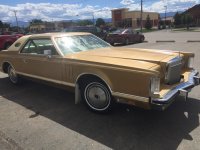 ImageUploadedByTapatalk1445319169.434859.jpg583.9 KB · Views: 454
ImageUploadedByTapatalk1445319169.434859.jpg583.9 KB · Views: 454 -
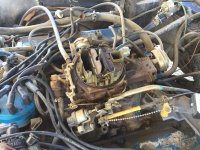 ImageUploadedByTapatalk1445319179.908778.jpg727.7 KB · Views: 1,119
ImageUploadedByTapatalk1445319179.908778.jpg727.7 KB · Views: 1,119 -
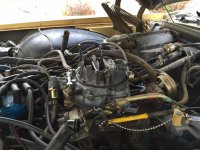 ImageUploadedByTapatalk1445319186.760559.jpg567.9 KB · Views: 741
ImageUploadedByTapatalk1445319186.760559.jpg567.9 KB · Views: 741 -
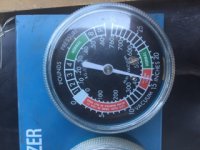 ImageUploadedByTapatalk1445319194.414979.jpg104.7 KB · Views: 715
ImageUploadedByTapatalk1445319194.414979.jpg104.7 KB · Views: 715 -
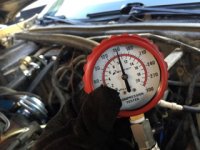 ImageUploadedByTapatalk1445319205.037273.jpg103.8 KB · Views: 716
ImageUploadedByTapatalk1445319205.037273.jpg103.8 KB · Views: 716



